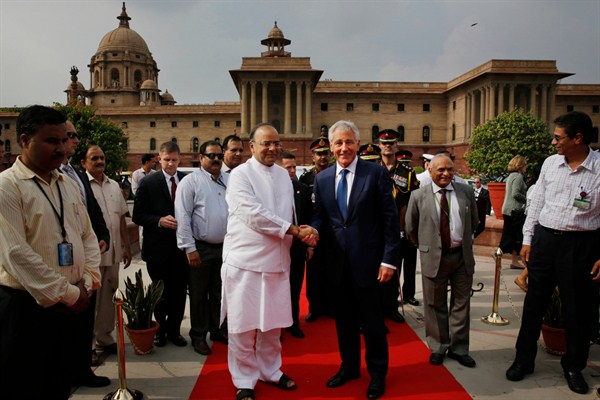Last week, U.S. Secretary of Defense Chuck Hagel visited New Delhi on a political mission to sound out Prime Minister Narendra Modi’s new government on the Defense Trade and Technology Initiative (DTTI) first proposed two years ago by Hagel’s predecessor, Leon Panetta. The United States is promoting DTTI as the “centerpiece” of the India-U.S. defense relationship going forward, hoping it will lead to a renewal of the New Framework for Defense Relationship signed by both sides in 2005, which expires next year.
The 2005 framework accord led to U.S. military sales totaling $9 billion to India, but that happened essentially in the wake of the 2008 civil nuclear agreement and with a government that is no longer in power in New Delhi. To sustain such defense ties with the new Indian government, which is heavily focused on leveraging indigenous weapons manufacturing for jobs and exports, Washington realizes that it has to move beyond episodic arms sales to co-development and co-production agreements. In that sense, the success of the technology initiative will largely depend on just how well the U.S. government and defense contractors are able to find technology collaborators within India’s defense sector, rather than mere offset partners. The Americans must also jostle for space with rival Russian, Israeli and French firms in an Indian environment where foreign direct investment norms have been somewhat liberalized.
To that end, U.S. authorities have communicated a list of specific proposals under DTTI to the Indian Ministry of Defense, including what one Indian official in the Defense Research and Development Organization (DRDO) describes as an “unprecedented offer” to co-develop and co-produce the next generation of Raytheon’s Javelin anti-tank missile. This is happening even as Israel’s offer on the Spike anti-tank missile is also under consideration. Other items on the U.S. list of proposals purportedly include cooperation on big data, a naval gun, a scatterable anti-tank mine system, a jet-powered unmanned aerial vehicle, naval multirole helicopters, the Hawk XXI surface-to-air missile and, rather interestingly, the electromagnetic launch system for India’s larger next-generation aircraft carriers. In addition, New Delhi and Washington have been exploring potential cooperative research in high-temperature superalloys, nanotechnology-based chemical and biological warfare detection, roadside bomb deterrents and military neuroscience.

